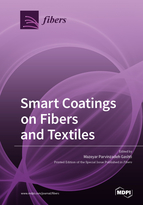Smart Coatings on Fibers and Textiles
A special issue of Fibers (ISSN 2079-6439).
Deadline for manuscript submissions: closed (1 April 2019) | Viewed by 94769
Special Issue Editor
Interests: electrospinning for tissue engineering applications; biomineralization
Special Issues, Collections and Topics in MDPI journals
Special Issue Information
Dear Colleagues,
Today, we know that nanotechnology has been considered extensively in fiber and textile engineering in order to perform new functionalities. Ultrafine nanoparticles can transfer their intrinsic properties to fibers and textiles by surface coatings. Although several research studies confirmed such functionalities, research is still in progress in laboratories around the world to establish further results. Smart coatings can also be performed on textile products through other methods, such as plasma and laser coatings, sol-gel techniques, magnetron sputter coating, layer-by-layer techniques and crosslinking using polymers. Several properties are demonstrated using these methods, such as antibacterial, superhydrophobic, fire retardant, self–cleaning, superhydrophilic, moth-proofing, electromagnetic shielding, and electrical conductivity.
In this Special Issue, original research papers, as well as reviews, are welcome. The goal is to gather contributions on various aspects related to smart coatings, including preparation, analyses, industrial uses, as well as their potential toxicity to humans during their usage.
I hope that this Special Issue will provide the scientific community with a thorough overview of the current research on smart fibers and textiles.
Dr. Mazeyar Parvinzadeh Gashti
Guest Editor
Manuscript Submission Information
Manuscripts should be submitted online at www.mdpi.com by registering and logging in to this website. Once you are registered, click here to go to the submission form. Manuscripts can be submitted until the deadline. All submissions that pass pre-check are peer-reviewed. Accepted papers will be published continuously in the journal (as soon as accepted) and will be listed together on the special issue website. Research articles, review articles as well as short communications are invited. For planned papers, a title and short abstract (about 100 words) can be sent to the Editorial Office for announcement on this website.
Submitted manuscripts should not have been published previously, nor be under consideration for publication elsewhere (except conference proceedings papers). All manuscripts are thoroughly refereed through a single-blind peer-review process. A guide for authors and other relevant information for submission of manuscripts is available on the Instructions for Authors page. Fibers is an international peer-reviewed open access monthly journal published by MDPI.
Please visit the Instructions for Authors page before submitting a manuscript. The Article Processing Charge (APC) for publication in this open access journal is 2000 CHF (Swiss Francs). Submitted papers should be well formatted and use good English. Authors may use MDPI's English editing service prior to publication or during author revisions.
Keywords
- surface grafting
- plasma and laser
- nanocomposites
- layer-by-layer
- sputter coating
- functionality
- toxicity.






